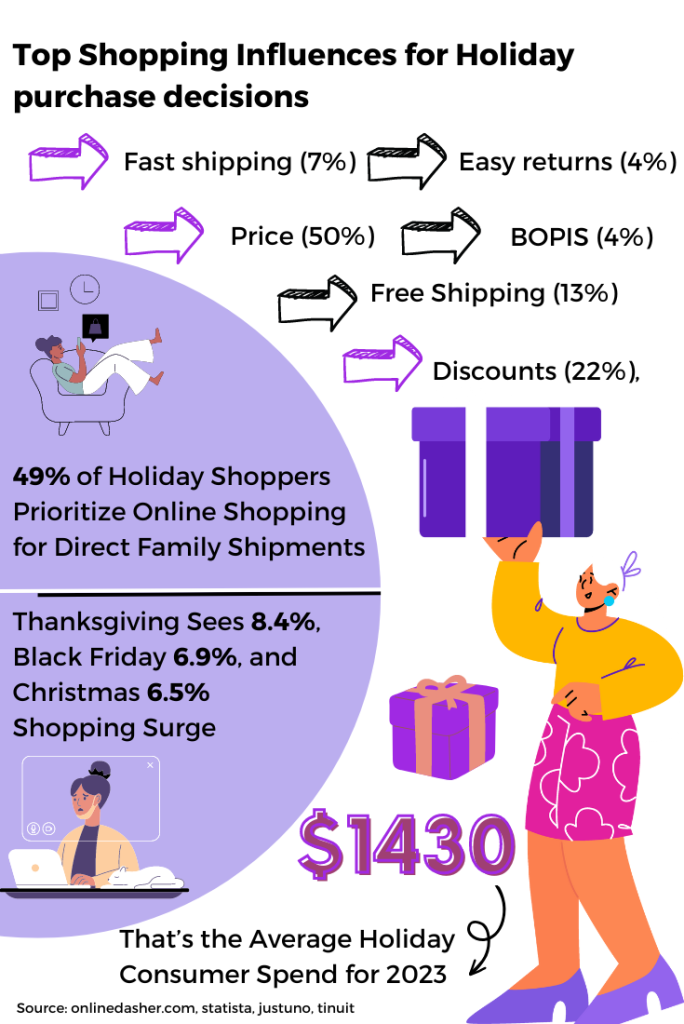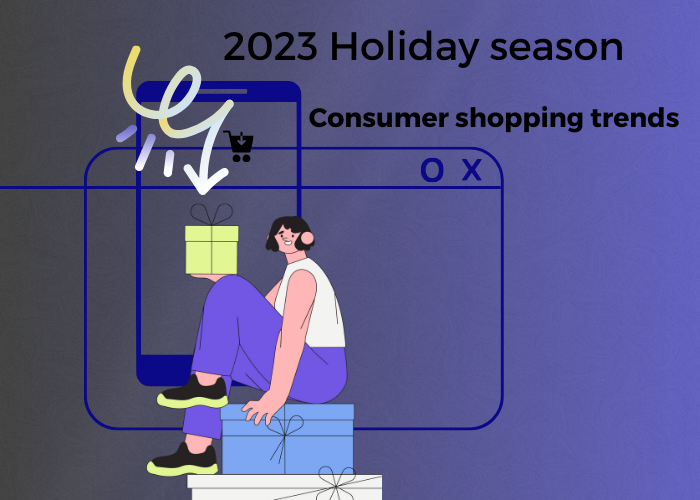Upcoming days to look forward to – Halloween, Thanksgiving, Black Friday, Cyber Monday, Christmas, Boxing day and New Year’s – which only means one thing for the e-commerce stores. THE BUSIEST SHOPPING SEASON OF THE YEAR. 59% of US consumers planning to shop online this year, and 63% of consumers are planning to spend more money shopping compared to the 2022 holiday season. [JustUno] It’s important that e-commerce businesses brace themselves to handle the holiday rush and keep up with the evolving consumer trends.
But, let’s face it. The e-commerce industry is more saturated than ever. There’s heavy competition in every single sector. People address different pain points to attract customers and customers are overwhelmed with choices. E-commerce stores constantly need to update themselves in order to stay relevant to this digital world. They need to understand what their consumers are looking for in a website while making a purchase. These behavior patterns constantly keep changing. The upcoming 2023 holiday season is no different. These consumer trends keep changing due to economic conditions and advancements in technology.
Let’s take a look at how consumers are planning to start their holiday shopping season and how different generations shop now.

Gen Z vs the Millennials vs the Gen X consumer trends
An average working-age person consumes social media 2 ½ hours per day. Two and a Half hours per day! It’s no wonder that Gen Z is heavily influenced by TikTok. They depend on social media platforms to get gift ideas and this generation embraces the ‘Buy Now, Pay Later’ payment model. Millennials, on the other hand, want faster delivery options and they choose to shop from brands that prioritize sustainability. Surprisingly, Gen X and baby boomers are open to shopping with new brands while still ‘value for money’ is the main factor that drives the purchase decision. Email remains a popular channel of communication across all the generations while SMS is slowly gaining popularity especially among Gen X and Baby Boomers. Brands should clearly know their target audience and tailor their strategy to align with consumer trends.
These consumer trends often shape the future of e-commerce. And with the holiday season coming right up, it’s time to strategically market to your customers. This year, the e-commerce world is ruled by six major trends. Follow these trends to increase ROI.
6 Consumer Trends Shaping 2023 Holiday Shopping
1. Resilience of Holiday Spending Amid Inflation
It’s true that inflation has caused anger and anxiety among shoppers but they are not backing down on holiday spending. Let’s take a look at some statistics that might surprise you.
- Overall, consumers plan to spend an average of $1,430 on gifts, travel and entertainment this year. (Statista)
- Gen Z and Millennials are not affected much by inflation, with 63% planning to spend the same or more during the holidays, as indicated by a Deloitte survey.
- 74% of consumers plan to spend the same or more on holiday gifts this year compared to last year. (Retail drive)
Despite inflation, consumer confidence around holiday shopping remains strong, offering a silver lining in a challenging economic landscape
2. 'Buy Now, Pay Later' for instant gratification
“Some shoppers will turn to buy now and pay later financing to make last-minute purchases, peaking at a record 9% the week before Christmas.” (Practical e-commerce)
“In the survey, 64% say they’ll use BNPL to buy gifts this holiday season. And many of those shoppers might fork over more money than they intended: Seventy percent of those surveyed say they would use BNPL to spend more than they had planned.” (Forbes)
‘Buy Now, Pay Later’ – the BNPL payment solution is emerging as the holy grail of the payment methods especially for the Gen Z shoppers. The unique selling point of this payment method is that it has a 0% interest rate which allows the shoppers to spend over their budget and still have flexibility and control over their spend. There are a number of advantages to using this BNPL payment method:
- It increases your average order value
- Increases the sales volume
- Reaches more customers
- Offers convenience
- Offers a better customer experience
3. Social Commerce: Scroll, Tap, Shop
Social media is the new search engine. And it’s so much more than that. Social media is the new ecommerce platform, it’s the new customer support center and it’s the new place where you can get honest reviews of a product. Social media can NEVER be overlooked. But do you get how this consumer trend shapes the realm of e-commerce?
Right from the top-of-the-funnel activity (awareness) to the bottom-of-the-funnel activity (Action), everything happens within this single platform. People are able to browse product catalogs and make secure payments. Apps like Facebook, TikTok and Instagram are redefining customer experience and brands have the unique opportunity to be more interactive and provide personalisation.
“37% of Gen Z plan to shop from Tiktok this holiday season” [Washington post]
And since most of the shoppers plan to get inspiration from social media for gifts, brands must leverage this to make the most out of social media. Moreover, social media can be great tool to gather information about the target audience without having to invest too much.
Shopify, an e-commerce platform, went one step further and partnered with tiktok to ease the social commerce trend. Find out how…
4. Mobile-first Approach: The Mobile Magic
This particular consumer trend hasn’t changed over years. Everyone has a mobile, through which they pretty much do everything. And with the rise of social commerce, mobile shopping has never been more convenient. Most of the e-commerce websites and apps are optimized to (and also prioritized to) a mobile first approach.
M-commerce isn’t the next big thing. It is a phenomenon that’s already happening
5. The Amazon Dominance
Amazon and other marketplaces set the bar so high for the pre-purchase and post-purchase customer journey. These marketplaces are one of the few to do so at the very beginning and they hold a very special place in the consumer’s heart. It is almost difficult to beat this image that these marketplaces have created.
It’s true that marketplaces offer a variety of products, seamless experience, faster shipping options, reliability, seamless return process, excellent customer support and so on. The list doesn’t stop here. It seems almost impossible to beat them right?
On top of all these strategies, you can offer a variety of payment methods, create the best loyalty programs and place additional incentives to keep the customers happy. This multi-faceted strategy ensures your brand stands out as a haven for hassle-free, customer-centric holiday shopping.
6. Premium Holiday Delivery preferences
The shipping experience sets the stage for retention and it cannot be emphasized more.
“With 31% of customers expressing their willingness to pay extra for faster and guaranteed delivery”, it’s clear that the concept of convenience and reliability holds significant weight in their purchase decisions.
Customers often get anxious about their gifts arriving on time. It’s important that the brands concentrate on what happens after the customer clicks the ‘buy’ button. Time is the essence of gift giving and people are even more likely to choose premium delivery services in order to get the delivery during the right time. Retention is an important part of the sales funnel. Don’t lose your customers to poor delivery experiences. Reap the rewards of customer loyalty, brand perception and continued success through a great delivery experience. Giving a good delivery experience is not a consumer trend fad but rather a strategy that is here to stay.
Bottom Line
Amid economic uncertainties, consumers still don’t show any resilience towards spending money on gifts for their loved ones. E-commerce brands should monetise this opportunity and attract customers through various marketing channels and convert them by offering an array of options and discounts. It is in the hands of businesses to cleverly strategise according to the evolving consumer trends and make this holiday season a blast. It is important that the etailers turn these one-time holiday shoppers into lifetime customers with their retention strategies.




